
NO ONE IS ALLOWED TO SEE OUR PRIVATE PARTS
NO ONE IS ALLOWED TO TOUCH OUR PRIVATE PARTS
NO ONE IS ALLOWED TO TALK TO US ABOUT OUR PRIVATE PARTS
WE ARE ALSO NOT ALLOWED TO SEE, TOUCH OR TALK ABOUT SOMEONE ELSE’S PRIVATE PARTS
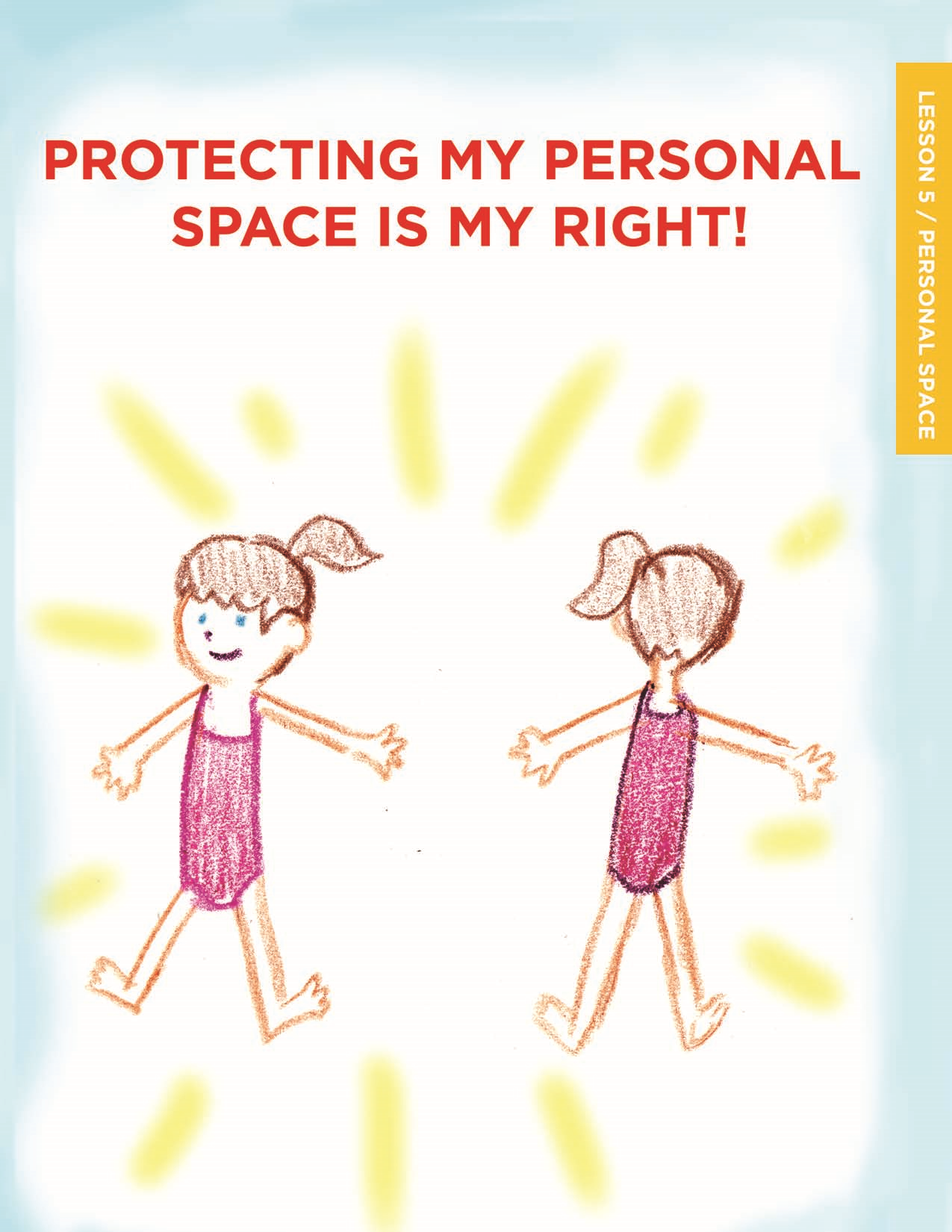
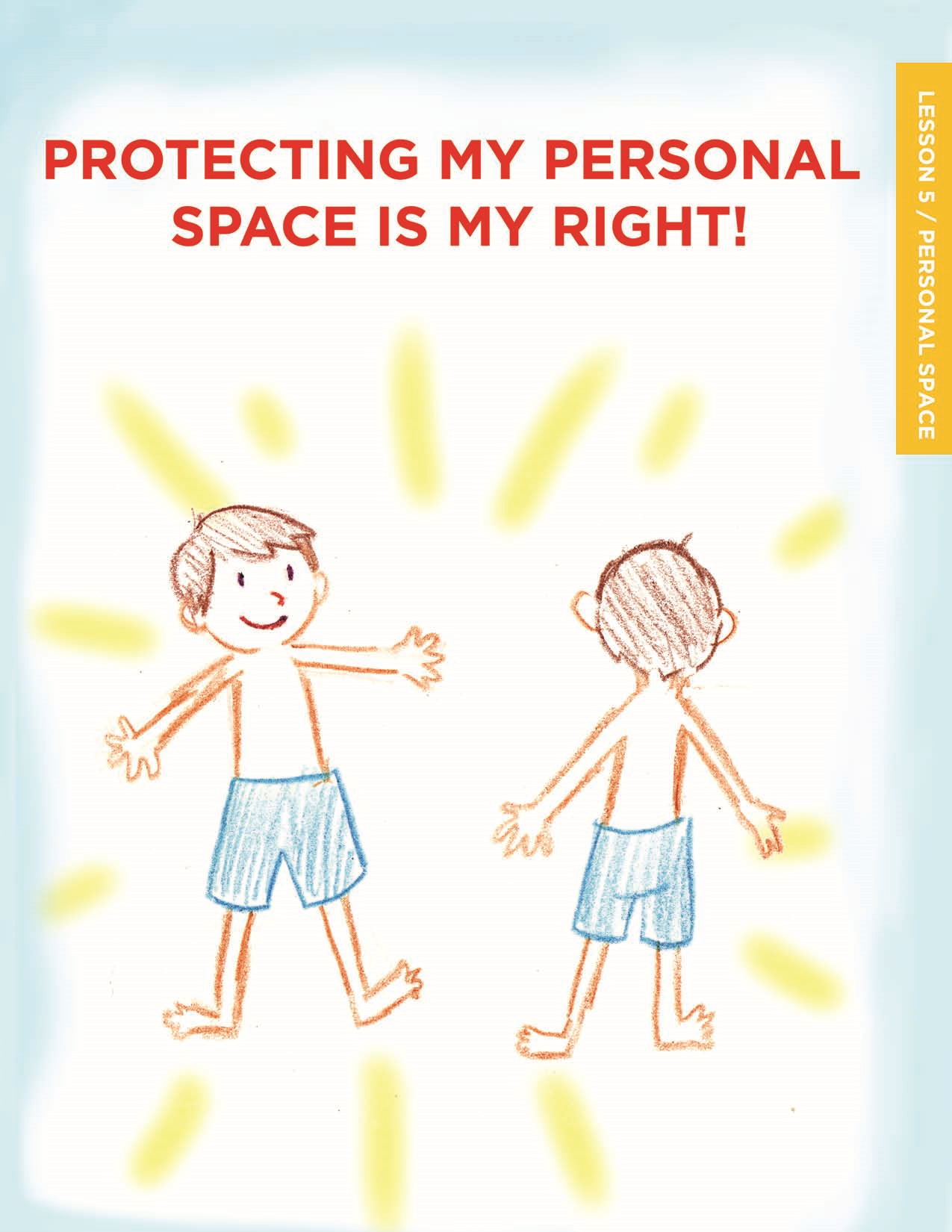
Today we will be speaking about a very important rule when it comes to our Personal Safety. Before we begin, I want to ask you a question. Do you have anything in your lives that you really love, is only yours, is very special to you and you don’t want anyone else to touch, look at or use?
(Have kids give examples ex. baseball cards, collections, money, diary.) Why don’t you want anyone to touch those things of yours? (they are private/personal).
What is the difference between the word public and private? (use a teaching card). (public means for everybody and private is just for you).
(Use traffic light teaching card) Hashem created our bodies in a very special way. Let’s start with our hands, based on what we just spoke about, would you say it’s a public or private part? (pick up your hand and talk about how everyone can see it so it’s public, go through some more like eyes, and ears) We also have parts of our body that are that are only for us. These are called our private parts. They are covered by a bathing suit or underwear and undershirt.
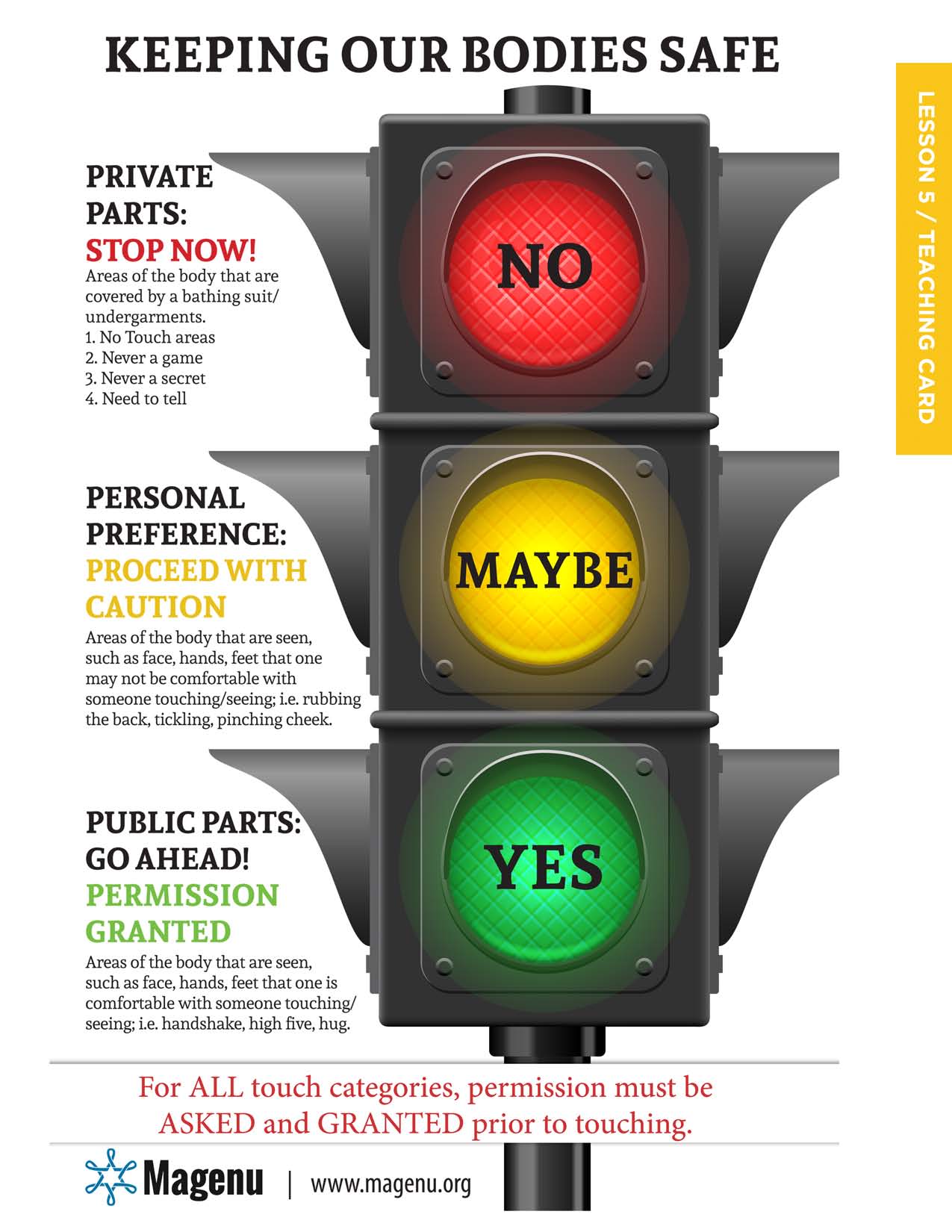
*Kids will usually giggle at this part so use it. You can say something like, “You see how you’re all giggling now because it feels uncomfortable that I’m saying that. Hashem gave us all such a special gift that we know when something feels uncomfortable. We may have a funny feeling in our stomachs, or we may even giggle, that’s the feeling we need to pay attention to. It can tell us when something is not right”
(Show bathing suit card).
NO ONE IS ALLOWED TO SEE OUR PRIVATE PARTS
NO ONE IS ALLOWED TO TOUCH OUR PRIVATE PARTS
NO ONE IS ALLOWED TO TALK TO US ABOUT OUR PRIVATE PARTS
WE ARE ALSO NOT ALLOWED TO SEE, TOUCH OR TALK ABOUT SOMEONE ELSE’S PRIVATE PARTS
This rule applies to everybody, which means even if it is a cousin, uncle, grandmother, brother, sister, or friend in your class. No One is allowed to touch, look at, or talk about your private parts because your body is yours and you have a right to keep your body safe!
I have a question for you, does that mean that a public part of your body I can touch when I want because it’s public? Can I just walk over and pinch your cheeks? Can I grab your hand really hard? No, I still need to respect you as a person and what may be ok for one person may not be ok for another. (Hand out baseball, STOP, THINK, ACT sheet to reiterate this point and do the sheet with the class).
STOP: take a deep breath
THINK: I’m feeling comfortable vs. uncomfortable –maybe the coach is pinching me too hard, maybe I’m not comfortable with someone touching me, maybe the coach has made me uncomfortable before and I don’t want him to be so close to me.
I don’t have to just stand there and let him touch me.
ACT: I can say, “Excuse me, can you please not touch me, I’m not comfortable with
it.” Or if you don’t want to do that you can ask a trusted adult to help you figure out how to let the coach know.
(Have the kids hold up their thumbs super high and repeat “My body belongs to me” )
We have this rule because OUR BODIES BELONG TO US! Everyone raise your thumbs high in the air and say out loud with me “MY BODY BELONGS TO ME!”
Why would this boy be uncomfortable telling the coach to not touch his shoulders? Can you think of any reasons? (*here we are looking for the children to discuss being afraid or not comfortable to tell an adult or older kid to stop because they are embarrassed or feel that it is wrong to go against authority).
Sometimes we are scared, shy, or embarrassed to say NO! STOP! That’s okay. It is still not your fault.
The most important rule we need to remember is what we learned in our first class is that:
Let’s talk about what we consider Safe Touches. (use teaching cards)
1. You are at the doctor for a well check and he has to check your whole body. Is this a safe touch or an unsafe touch? Why? The doctor is trying to keep you healthy and someone is usually in the room with you (mom, dad, caregiver) so it is not a secret. It may not be comfortable being at the doctor, but because it is not a secret it is a safe touch.
2. Your father comes home from work/yeshiva early so he can spend some time with you. You sit on his lap or closely next to him. You feel safe and happy. Is this a safe or unsafe touch? Why? You feel comfortable and it does not involve private parts of the body so it is a safe touch.
3. Your rebbe (teacher) high-fives you for asking a good question in class. Is this a safe or unsafe touch? You feel great about yourself. It involves your hand (a public part) and it is in front of the whole class so it’s definitely not a secret. This is a safe touch. (Discuss the fact that a child may be uncomfortable with the attention or may have sensory difficulties and not enjoy being touched. This child can tell the Rebbe quietly during recess that he appreciates the positive attention but really has a hard time with the touch. If he does not feel he can do this, he should tell a trusted adult to help him work it through).
4. You are at a crowded concert with your older sister trying to find your way to the rest of your family. She grabs your hand as you both make your way through the crowd. Is this a safe or unsafe touch? Your sister does not want you to get separated from her since there are so many people around. She is holding your hand tightly, but it is to keep you safe so you feel protected. This is a safe touch.
Now let’s talk about examples of touches that may be unsafe and how we use our STOP, THINK, ACT steps to figure it out. (use teaching cards)

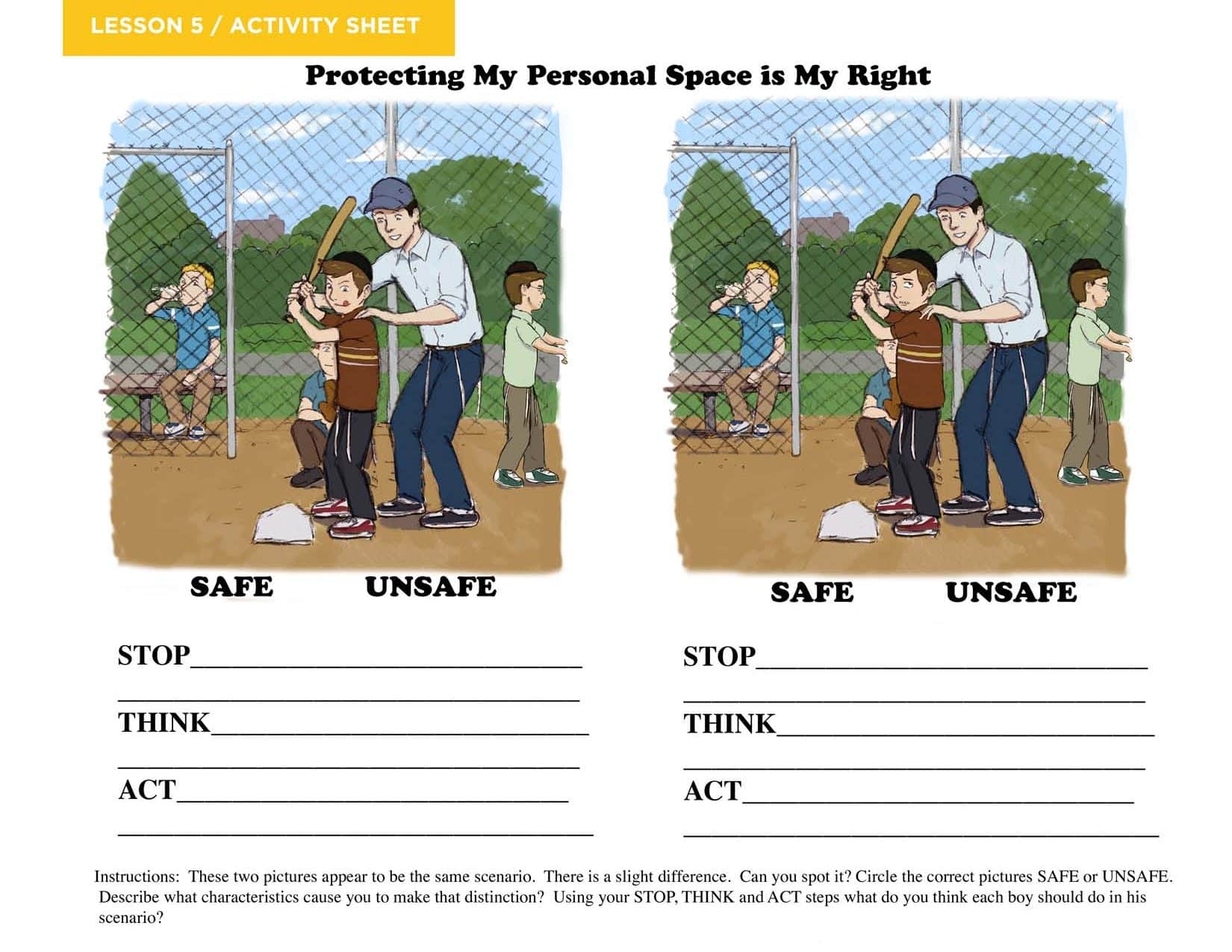
1. (*tell the story with details) This boy loves his uncle and enjoys it when he visits. He is funny and is always making jokes. Sometimes he tickles the boy and usually, it’s ok, but on this visit, the tickling
lasts too long and the boy is having trouble breathing. The boy also thinks that the tickling is on his private parts. Is this a safe or unsafe touch? What should the boy do?
STOP: take a deep breath
THINK: I do not like this, I love my uncle, but this tickling feels weird. Private parts are not for touching. I can’t breathe so it definitely does not feel safe.
ACT: I can stay, Stop it, I don’t like it. If I can’t do that I can tell a trusted adult.
Discuss not necessarily being able to do these steps at the time that it is happening. Remind the children that it is okay to tell a trusted adult after it happens or after the uncle leaves.
Explain to the children that even if they love their uncle it is ok to tell because an unsafe touch is never tattling (loshen horah).
Explain to the children that even if they took a treat from their uncle after the unsafe touch it is still not their fault and they still need to tell a trusted adult.
Even if the child forgets about it and doesn’t remember what happened until the uncle comes to visit again, he/she can always tell no matter when it happened. THERE IS NO TIME LIMIT ON THE TELL.
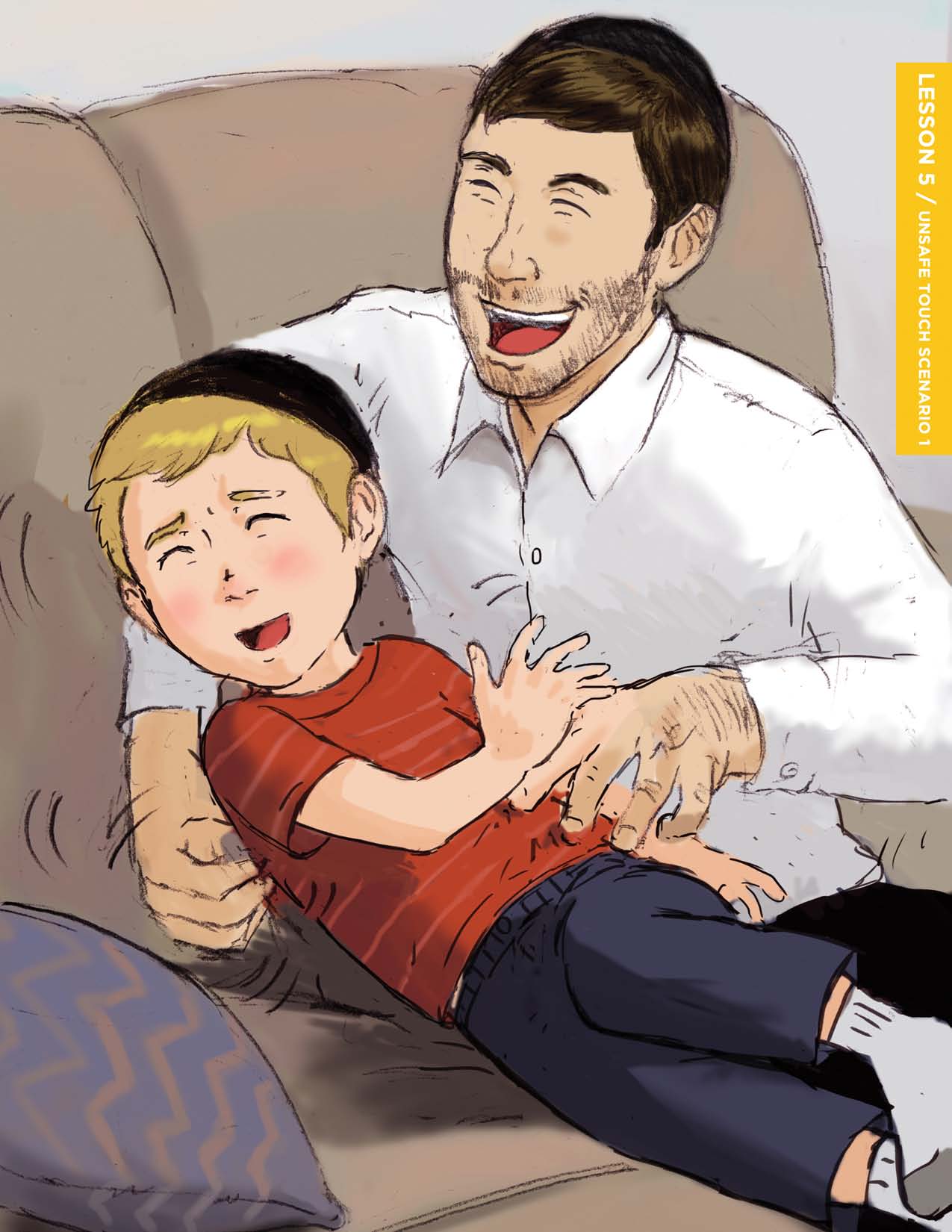
2. You’re standing in line for lunch and the person behind you is too close to you. It is making you feel uncomfortable. Is this a safe or unsafe touch? What do you do?
STOP: take a deep breath
THINK: I am feeling claustrophobic, annoyed, frustrated. This person is in my personal space. It is making me feel uncomfortable.
ACT: First, nicely say “Please back up you are in my personal space.” If the person does not move tell the students to find a grown-up in charge to tell in order to get help.
Now is a good time to discuss boundaries using the boundary worksheet to help with this point.
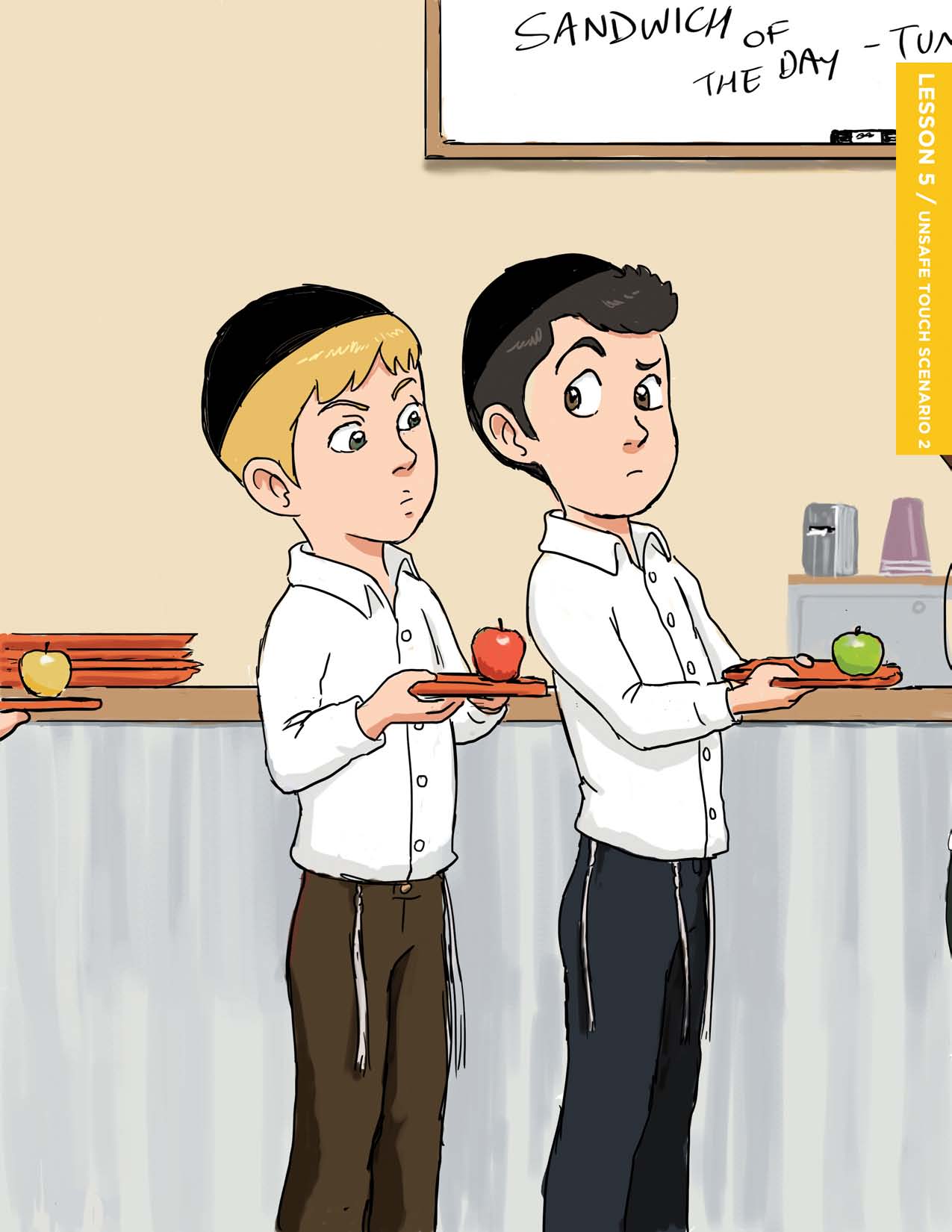
3. One girl offers you chills and it feels nice, but then 2 more girls join in and it starts to feel weird. Is this a safe or unsafe touch? what do you do?
STOP: take a deep breath
THINK: I’m feeling uncomfortable, nervous, funny feeling in my stomach, scared. This is a touch that went from a safe touch to an unsafe touch.
ACT: Tell the girls to stop, you don’t like it anymore. If they do not listen, find a grown-up in charge to help and tell a trusted adult.
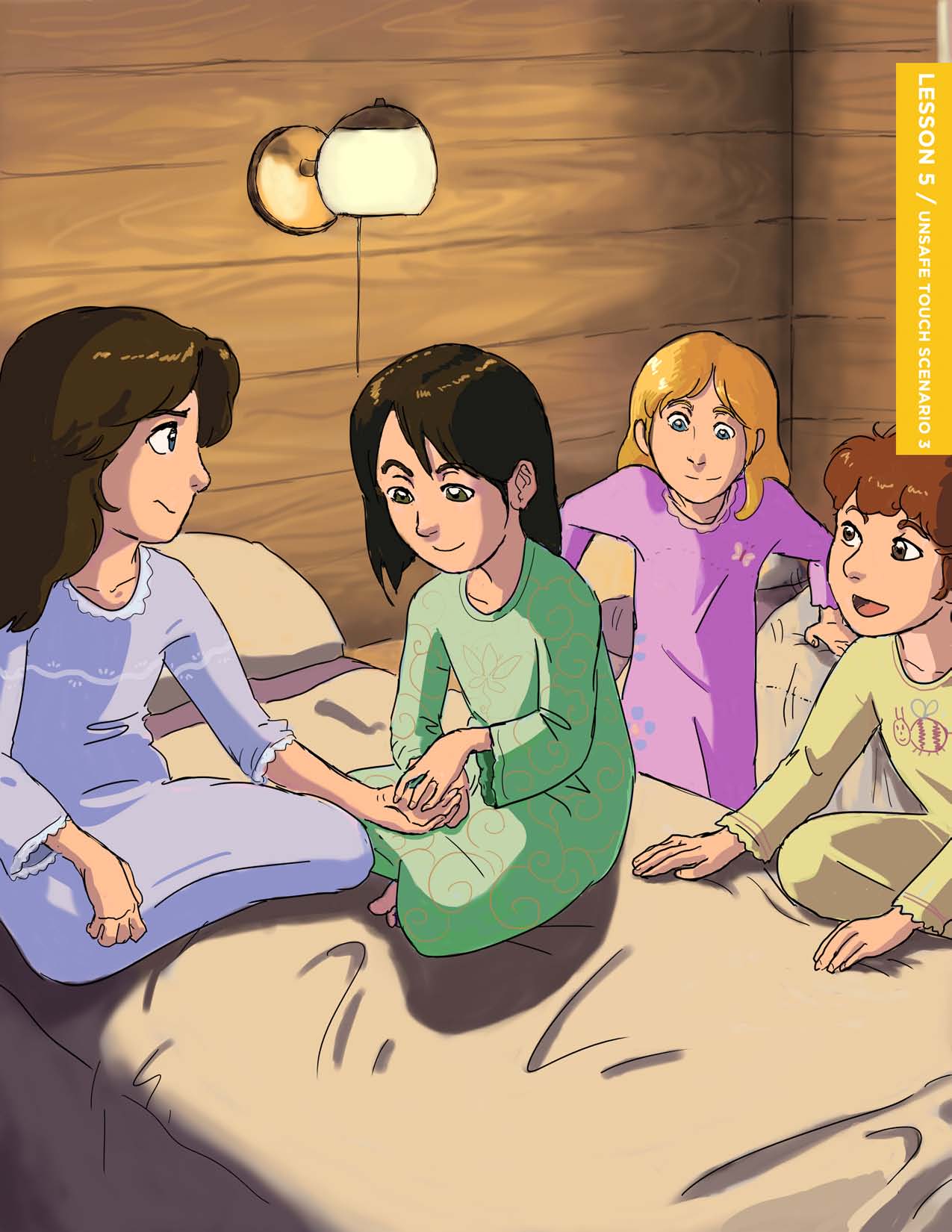

This lesson may bring up questions that can be difficult. Try not to dismiss anything or get flustered if a child says something that
sounds like a disclosure or something to look into more. Answer questions as fully as you are able and then tell the child you will find out what you don’t know. Contact our office or another professional for any questions you need help answering. To handle a disclosure or to make a report, please consult the last section of this manual.